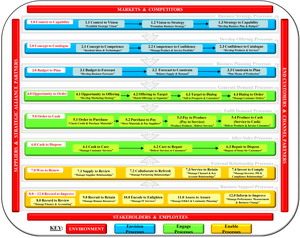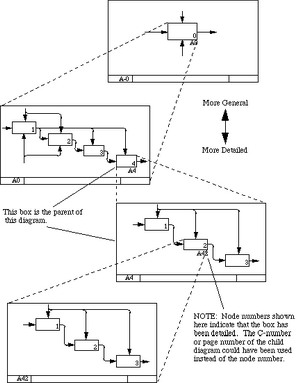Process Model Layer
The process model is the second step on our routemap and as has been said before it should reflect a somewhat general view of what the ‘To-Be’ future state will look like, but completed to only a certain level of detail.
The Biz4ge version of this process model is constructed to be generic and cross-industry and is depicted in the figure below (click on it to see an enlarged version in a new window).
This figure will be recognisable to many readers as having relevance to their own organisations. However, we freely acknowledge that any generic, cross-industry model will not meet everyones requirements, nor is it meant to. What is presented here and on this website is a platform that you can use as-is or modify, extend, add, delete or ignore parts until is it what you want or need it to be.
What is depicted in the diagram are process decomposition levels 0-2 inclusive. Most business architectures typically extend down to process decomposition level 3……and occasionally level 4, usually dependent on the ‘size’ of the area being decomposed.
This can be described as a ”What’ Mapping exercise that documents the high-level (and typically) non-executable processes……these are also sometimes referred to in business architecture terms as the ‘capabilities’ an organisation must possess to operate effectively. At this level of detail a simple and effective approach (e.g. IDEF) to mapping can be used.
At lower levels of decomposition (i.e. process decomposition levels 3+/4+, the ‘How’ Mapping) that are normally developed later in the business transformation Design stage the processes increasingly become (typically) executable workflows. Hence it may be desirable at these levels to use a mapping format and toolset directly supportive of workflow automation (e.g. BPMN) in the event that approach should prove necessary or appropriate for some process use cases.
Of course, to keep things simple, you may choose to use a single style of mapping and notation from top to bottom. With IDEF this is straight-forward, although its not the best choice if significant workflow automation is a major consideration. Alternatively, some more modern ‘richer’ notations like BPMN are designed to be much more detailed, rigourous and structured (and hence have a higher learning curve)…..as they must be to deliver working automated workflows (i.e. BPEL) as an output.
So, although you can easily use BPMN for top-level (i.e. ‘What’) mapping you will generally have to relax or bend some of the stricter rules and conventions that must normally be observed to enable the automated workflows that might be expected as a deliverable output of lower-level (i.e. ‘How’) mapping.
But, so long as you do it intelligently this should not be an issue. The top-level process maps found in a business architecture are really core meta-processes, business ‘capabilities’ and organisational context setters rather than detailed workflows that would be automated and executed as such!
 For some ideas for modifying our process model to your own requirements you can also reference the excellent APQC or SCOR Models for which links are provided on our Resources page……each of these organisations has material covering both generic, cross-industry processes as well as industry specific ones. We have been swayed by these and other influences in constructing our own process model.
For some ideas for modifying our process model to your own requirements you can also reference the excellent APQC or SCOR Models for which links are provided on our Resources page……each of these organisations has material covering both generic, cross-industry processes as well as industry specific ones. We have been swayed by these and other influences in constructing our own process model.
Which brings up one further point about the APQC PCF ……its organising diagram looks like a top-level process model and the content is free for non-commercial use……so why not just use that instead of the Biz4ge version?
You could try to do this, but what you would quickly discover as you looked at it more closely is that the APQC PCF is a CLASSIFICATION framework. In other words it is designed as a vehicle to put every process into a particular class or category and this has been done along highly functional lines.
This is exactly what you might do if your main goal was to a build a framework to be used for classifying, recording and retrieving industry benchmarks in a database….which is what the APQC states quite clearly is the purpose of the PCF! Why does this matter?
Well, for a number of reasons, but perhaps most obviously because functional groupings are not processes! For example, if you examine the PCF (e.g. in the distribution class) you will find processes in that PCF area relevant to forecasting, planning, scheduling and execution……all in the same class having to do with distribution.
In a process model these processes would typically be spread across different processes with the different time horizons and trigger points relevant to those processes (i.e. forecasting activities are not generally performed in the same process as execution activities)!
This is not a negative reflection on the APQC, which offers what is in our opinion an excellent resource….it is just a case of horses for courses……and the Biz4ge process model is the right horse between the two in terms of process modelling!
 If the content of this webpage makes you feel that being a member of our Biz4ge Network, or a Certified Affiliate within it, would be of benefit to you please Contact Us and we will get in touch by return. Your contact will be treated as confidential and will be at no cost or obligation to you.
If the content of this webpage makes you feel that being a member of our Biz4ge Network, or a Certified Affiliate within it, would be of benefit to you please Contact Us and we will get in touch by return. Your contact will be treated as confidential and will be at no cost or obligation to you.

